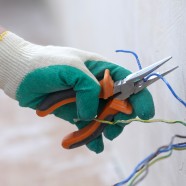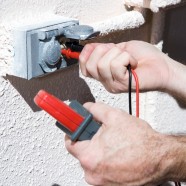How Advanced Lighting Controls are Changing the Face of Commercial Lighting
You’ve heard of smart buildings and building management systems, but you might not have heard specifically of advanced lighting controls, or about how new technologies are making it possible to automate lighting and create more energy efficient spaces.
That is exactly what many companies are doing in commercial buildings, and as an electrical contractor in South Florida, we are excited to see how these commercial lighting advances can benefit our commercial and residential electrical customers.
How Advanced Lighting Controls Work
Lighting controls can be a simple as sensors and switches, or a much more complex system linking many different light fixtures and switches. In their simplest form, they may use day/night or photosensitive switches to manage lighting in a smaller commercial or residential building, but single fixtures or a series of many may also be routed though network bridges to digital management systems and integrated with other building management systems to allow for remote control.
That advanced technology offers so many exciting benefits, including exponential improvements in control, timing, and programming, as well as reporting and even remote control.
Essentially, as buildings have got smarter, so has the technology available to manage them, and today, the level of control over lighting and other systems can be as complex or simple as a building owner chooses. These controls are far superior on a granular level, and offer management possibilities that are as different to legacy system as, well, day and night!
What Are the Benefits of Advanced Lighting Controls?
Older, legacy, analog-based lighting controls were not much more flexible than the dimmer switches your parents or grandparents had in their 1970’s home. They were clunky and cumbersome, and they offered a limited range of settings and control.
Today, with the range of digital lighting controls to choose from, we can offer customers an almost infinite number of settings and a layered control system that allows for complex parameter setup.
That, in turn, can lead to greater energy efficiency in buildings, improved security and increased comfort for building occupants. Since these smart lighting systems also minimize operation time for lighting installations, they also reduce long-term maintenance costs for the buildings they are installed in.
Going Smart
For our commercial clients, going digital with lighting controls makes a lot of sense. The good news is that it does not have to mean a complete replacement of all of your current lighting systems. Many advanced lighting systems can be retrofitted to existing systems with minimal changes in wiring and equipment.
Customers who do choose to upgrade both their aging lighting equipment and the management system that runs them can take advantage of existing energy savings by utilizing advanced lighting equipment based on LED and other technologies to reap the maximum efficiency benefits.
Whether you choose to upgrade your lighting and your management system, or whether you retrofit your existing system now with a view to upgrading in the future, it is certainly an exciting time for lighting, and there are sure to be major leaps in management and control to come. An experienced electrical contractor in South Florida can provide all the advice and assistance you need.
Read MoreHow to Run New Wires Through Your Home’s Old Walls
If you’re buying an older house, or your family has grown since you bought your existing home, remodeling and renovation are probably on your mind. Bathroom and kitchen remodeling are the most popular renovation jobs in the country, but you’ll have to think about residential wiring no matter what room you want to work on. Electrical remodeling can be as simple as adding an outlet or as complex as creating an entirely new circuit for part of a room. While elaborate jobs should always be left up to professional electricians, you can do some simple tasks if you’re confident with basic tools.
Preparing for the Job
Doing your own electrical remodeling is only possible if you’re fanatical about the safety rules. If you never cut any corners you’ll be able to do some simple jobs, but if you’re the type to take shortcuts, then rather leave the job to the professionals.
If you do want to proceed with the project, begin by turning off the power to the room at the breaker box. If it’s too dim in the room, use bright flashlights to see your work. Use a voltage tester to make sure the outlet you’ll be working on doesn’t have any power going to it. Once you’re sure there is no power running to the outlet, remove any objects hanging on the walls in that area, such as televisions or paintings. Use a stud finder to locate the studs in the wall, and mark them with a pencil.
Making the Cuts
The phrase “measure twice and cut once” may never be more important as it is in reference to making holes in your wall. Be very strategic in the placement of the holes so that you don’t make larger ones than necessary.
Measure and draw outlines with a pencil for all the drywall holes you need to make. Cut a hole across all studs for easier access to the area you’ll be working in. Use a drywall saw to make clean cuts, and set each square aside after you remove it. You’ll be replacing these squares when the electrical work is finished. If you’ll be traveling the wire for the length of the wall, cut an interim hole to help you to guide it to its final destination.
Use a right-angle saw with a round bit to cut holes through the studs for the wires to go through. You can rent these specialty saws through some hardware stores and most home improvement centers. If you’ll be running multiple cables through the wall, such as for a wall-mounted television, drill a separate, larger hole for holding conduit.
Running the Wires
Begin at the highest point and run the wires down through the inside of the wall. Gravity will help the wire to go where you want it to, but if you have any problems sending the wire to the right place, use fish tape to guide it. Fish tape, otherwise known as an electrician’s snake, is a long coil of wire designed to help pull wires through long expenses of wire. It’s coiled up but stiff, much like a metal measuring tape.
Feed the end of the tape through one hole in the wall and feed it toward the other end. Once you see the end of the fish tape, attach it to the wire and coil the tape back up. The wire will follow along, emerging exactly where you need it. From there, you can proceed with installing your outlet.
Professional Help
Some small jobs covering small areas of the wall can be done by amateurs, but if you’re considering a large electrical remodeling job, allow a licensed electrician to do the job. They know exactly how to move wires through walls, the optimal spot for all new outlets, and the safest way to finish the job. Doing elaborate wiring work on your home is no job for a beginner. Electrical fires take out thousands of homes each year, and many of them could be avoided by using better electrical safety methods. Call a professional for anything but the simplest job, and even then if you’re not certain of every step to take to complete a safe and neat job.
Read More6 Types of Power System Protection
Florida’s power systems are taxed more than most states because of the extraordinary amount of lightning that strikes the state each year. You don’t need bad weather to experience power fluctuations, though. Voltage can ebb and spike for multiple reasons, causing anything from mild annoyance to life-endangering problems. The aim of the electrical protection plan is to isolate and fix the problem while keeping as much of the system running as usual. Different problems call for different solutions, but they all work together to keep the power running as normally as possible.
Transformers
Electrical voltage may vary between the power station and your home or business, and transformers work to raise or lower the voltage to the desired rate. They’re the first defense against overloading and brownouts, making use of electromagnets to keep the power steady as it feeds into your building. The resulting power is easier for the relays and breakers in your home or business to deal with.
Protective Relays
Relays are the electrical protection mechanisms that sense an increase in the power supply and trip the circuit breakers. When the power surges too high it can create a fire hazard. Relays prevent that by breaking the circuit through the use of breakers. They’ll work continuously, tripping the same breaker over and over again until the cause of the surge or excess draw is corrected or removed.
Circuit Breakers
Circuit breakers are the workhorses of the power system protection group. Connected to a system of relays, when the power surges too high it will trip, cutting off the power and saving delicate electronics you own. Power won’t flow through an incomplete circuit, and the relays in a circuit breaker are the simplest types to use.
In older buildings there may be a fuse box that employs a system of fuses that burn out when the relay trips. These have to be replaced, though, making the circuit breaker switches a great improvement. Circuit breakers can be simple setups serving only one outlet, as in ground fault circuit interrupters (GFCI) or in a traditional circuit breaker box panel that controls a series of circuits throughout the building.
Back Up Power Supplies
For homes and businesses with one or two computers, a battery operated backup system can be the perfect solution to surges and power outages. These devices are a link between the computer and the wall outlet. If the power goes out a battery backup system instantly creates enough power to run the computer or appliance for about half an hour. This gives you time to shut the computer down properly without losing important data. It also acts as a buffer, preventing surges from damaging delicate data storage. Most of these backups have rechargeable batteries installed, and constantly recharge themselves from the outlet power.
Lightning Protection
All the back power in the world won’t handle a direct lightning strike on your building. Air terminals, what used to be called lightning rods, focus the lightning’s power away from the building and directs it into a grounded area outdoors. It’s a myth that air terminals attract lightning. What they do is to protect your property from any lightning that does happen to strike. You can install lightning protection on your home or business, and can even have specialty protection added to important landscape details such as tall trees and large shrubbery.
Generators
Backup generators don’t prevent a power surge or dip from happening, but when there is a loss of power they immediately start up, preventing the damage that sharp dips and rises in the power system can do to computers, stereo systems, medical devices, and other items that need a constant power source. When your business or your health depend on keeping a constant power supply, it’s crucial to install a reliable backup generator capable of putting out enough power to run critical systems in your building.
Read MoreThe Role Electrical Maintenance Plays in Home Safety
For busy people, having an electrical maintenance contract can be a great time saver. No more worrying about finding spare time to do all the maintenance around the house. No more wondering if you’ve done everything you’re supposed to. But that’s not the only reason to sign up for maintenance agreements. Having regular electrical maintenance appointments can be a key factor in your home safety in multiple ways.
Fire Hazards
One of the leading causes of home fires is problems with electrical wiring. The heat from electrical wiring can degrade and eventually break down their protective covering, leaving bare wires which can easily spark and start a fire inside your home’s walls. You may be able to tell some of the more obvious signs of old wiring such as:
- Breaker switches going off frequently
- Brown, discolored wall outlets
- Getting shocked when you plug in or touch an appliance
The problem is that once these signs are visible the trouble with your wiring has become a serious danger. Residential electrical contractors are trained to discovered problems with your wiring and electrical system before they become dangerous. Your contractor will perform regular electrical maintenance, repairing or replacing parts that have begun to wear out before they get to the point where they might start a fire.
Outdoor Lighting
Your electrical maintenance contract can include your outdoor lighting system, both in landscapes and on paths and buildings. When your contractor replaces bulbs on a regular basis and installs brighter bulbs to illuminate outside your home, it’s safer in two ways. First, brighter lights along walkways and on porches make it easier to walk into your home after dark, cutting down on the problem of tripping over objects you can’t see. Guests to your home can safely walk on unfamiliar paths, as well.
In addition, having reliable bright lighting outside your home is a great burglar deterrent. Most thieves don’t like to operate in bright light; they prefer breaking into homes when it’s dark and difficult for anyone to see them. Bright lights on your porch and motion-activated floodlights on your property can repel all but the most determined burglar.
HVAC
For some people, having the HVAC system in their home working well isn’t just a convenience, it’s a matter of life and death. Senior citizens, especially, are vulnerable to extreme heat variations on both ends of the thermometer. A furnace that goes out in the dead of winter in the north or a power outage that prevents air conditioning from working in Florida can be a danger to the youngest and oldest members of your family.
Allergies are a huge problem for some people here in southern Florida, and many HVAC units are equipped with filters that screen out molds and pollen. If you’ve got a child or other family member with extreme allergies, keeping that filtered air moving is a bit priority, and regular maintenance is the best way to make that happen.
Your contractor can find problems before they start, making electrical repairs while they’re still minor inconveniences and reducing the chance of you having to suffer through a dangerous heat wave without air conditioning.
The DIY Fan
Some families have a member who’s an avid DIY fanatic. They’re convinced they can do every repair necessary on their own home. Unfortunately, many of these people suffer serious shocks when trying to repair or replace their own electrical wiring or appliances. Some simple repairs are easy enough to do yourself, but not all wiring troubles are in a DIYer’s knowledge base. If you have an electrical maintenance agreement with a professional contractor, he’ll spot and repair any problems before your DIY fan can even find them, in most cases. If not, a valid response to them is to ask them to wait for the contractor instead of wasting money they’ve already spent.
Read More




Recent Comments